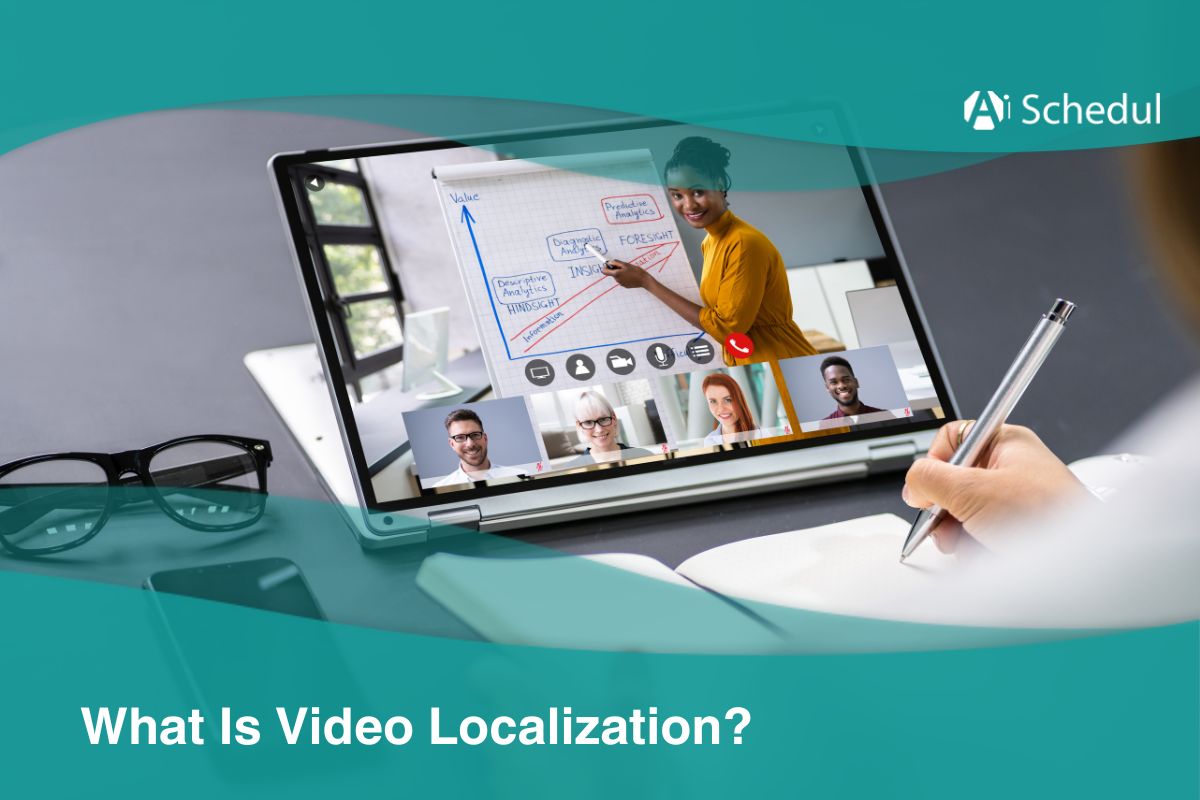Video content is one of the most powerful ways to reach audiences. However, if it isn’t designed for various languages and cultures, its impact can be limited. That’s where video localization comes in.
From adding different subtitles to using online video translators, there are different methods to make your video content get a global reach.
In this post, we’ll walk you through what video localization is, why it’s essential for global growth, and how you can start making your videos truly connect with international audiences.
Let’s get started.
Table of Contents
What is Video Localization?
In an age where nearly 5 billion people use social media worldwide, video localization has become an indispensable part of any video marketing strategy.
Localizing a video means adapting a video’s content to a specific language and culture so that it feels tailor-made for the target audience.
However, it is not just a simple translation, true localization might also require rewriting phrases to fit cultural context, swapping graphics or symbols, and ensuring the content aligns with local customs.
If done well, the localized video will evoke the same emotions and message as the original, but for a new audience.
Seems difficult, right? But don’t worry, in a world where AI is getting smarter each day, localizing video content has become much easier than before.
Before exploring the methods for social media video localization, let’s first examine the advantages of having a video localized.
Benefits of Video Localization
Although English is the main language used on the internet, it should be noted that non-English speakers make up around 75–80% of internet users. So, if your videos are only in English, you’re potentially missing out on a huge audience.
Here is what you get by video localization:
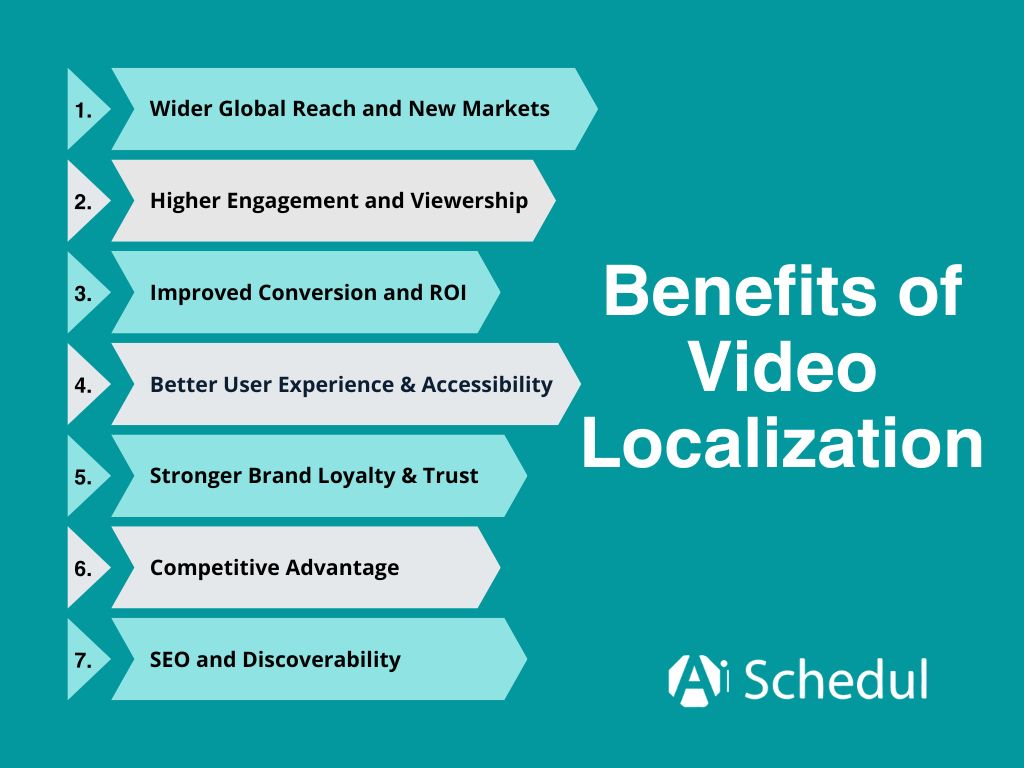
#1 Wider Global Reach and New Markets
Who doesn’t want to reach more people on the internet? Whether on social media or a website? It’s always beneficial to gain more viewers, audience, and customers, isn’t it?
By providing content in multiple languages, you access new markets that were previously unreachable due to language barriers.
#2 Higher Engagement and Viewership
People usually share content in their local language. They are also more likely to watch and like a video that they completely understand. Localized videos feel more relevant, which boosts engagement metrics.
#3 Improved Conversion and ROI
Video localization isn’t just about views; it can make the audience take actions like sign-ups or sales. When people understand your message completely and feel you’ve communicated in a way that resonates with them, their trust and willingness to buy increase.
This leads to a higher conversion rate and a greater return on investment.
#4 Better User Experience & Accessibility
Localization makes content more accessible and gives your audience a better experience surfing your social media channel.
That’s because not everyone speaks your video’s original language, so providing translations (via subtitles or dubbing) ensures they can get value from the content.
This is especially important for educational or how-to videos, product demos, etc., where understanding is critical.
#5 Stronger Brand Loyalty & Trust
People will trust brands that respect their culture and language. It shows you care about them, and customers feel “seen” and understood, making them more likely to trust your brand.
#6 Competitive Advantage
Delivering content in the viewer’s language helps build a relationship. They’ll remember that your brand made the extra effort to communicate with them directly, which sets you apart from competitors who don’t localize.
#7 SEO and Discoverability
Localized videos can improve your search visibility in other languages. For example, a YouTube video with translated titles/descriptions or multiple audio tracks can appear in search results for those languages, capturing search traffic.
When Should You Use Video Localization?
Now that you know the benefits of video localization, let’s see if you need it. Check out the following situations, which require you to translate your videos into other languages:
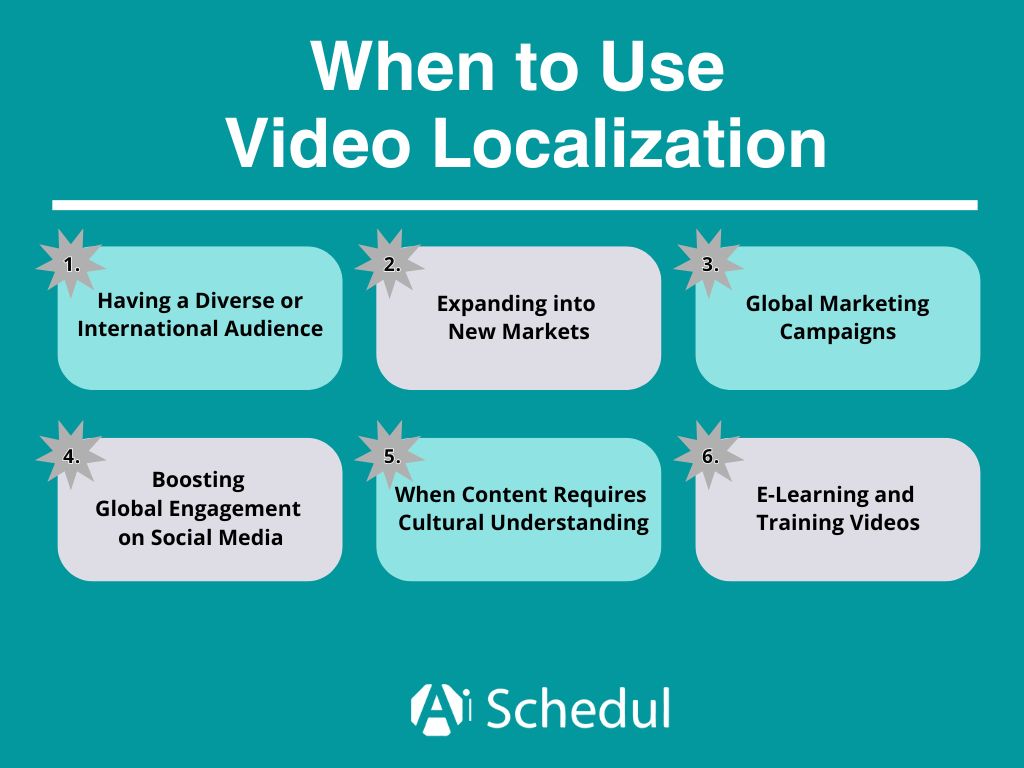
#1 When You Have a Diverse or International Audience
Check out your social media analytics. If it shows your content is getting views from non-English speaking countries, it’s an indicator that you need to change your strategy and add video localization to it.
#2 Expanding into New Markets
Are you opening a branch in another country, such as Germany or Japan? Now you need to change your content marketing strategy to expand your business into a new market.
Audiences are more receptive to your message if it’s delivered in their language at launch.
#3 Global Marketing Campaigns
For campaigns intended to run in multiple countries, such as an international ad campaign or a worldwide product release event streamed online, you should plan to localize the campaign videos.
Many global brands create a master video, then localize it into several languages. If you want to act like the leading brands in your niche, then using localization is almost a must for effectiveness.
#4 Social Media Content Aimed at Boosting Global Engagement
Perhaps you’ve seen great engagement on an Instagram post where you added dual-language captions, or you have a TikTok following that includes speakers in different languages.
That’s a cue that you need to add video localization to your social media marketing, such as your Instagram video marketing strategy.
#5 When Content Requires Cultural Understanding
Some videos may contain cultural jokes, references, or scenarios that won’t land with foreign viewers. If you still want the content idea to work globally, you should localize your video, whether by adding subtitles or dubbing.
#6 E-Learning and Training Videos
As a tutor who creates training videos, especially for platforms like YouTube, localization is very beneficial.
Providing translated video content (or at least subtitles) in such scenarios greatly increases comprehension.
Different Methods of Localization
Up until now, do you think you need to localize your videos? Let’s check out the video localization types:
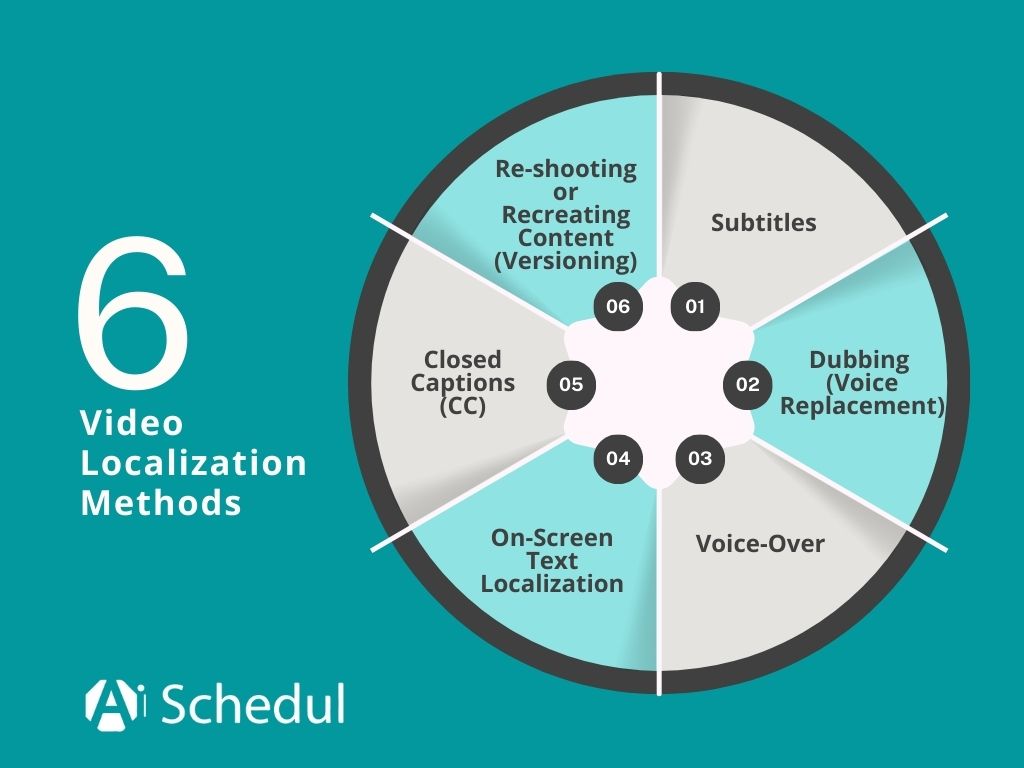
- Subtitles (Translated Subtitles): This is one of the most common and accessible methods. Adding translated text at the bottom of the screen. It’s affordable and keeps the original audio intact.
- Dubbing (Voice Replacement): Replacing the original audio with a new voiceover in the target language. Good for a more immersive experience.
- Voice-Over: Similar to dubbing, but the original audio is still faintly audible in the background (often used for documentaries or interviews).
- On-Screen Text Localization: Translating any text that appears within the video itself (signs, graphics, captions inside the video frames).
- Closed Captions (CC): Adding not just dialogue, but also sound descriptions (like [music playing] or [door creaks]) — usually for accessibility. It is one of the video translation methods on Instagram.
- Re-shooting or Recreating Content (Versioning): For some projects, brands completely re-shoot the video for a new audience, adapting cultural references, visuals, and messaging. However, it’s not only time-consuming but also will be so expensive.
How to Do Video Localization
Well, it’s time to get started with a video localization strategy.
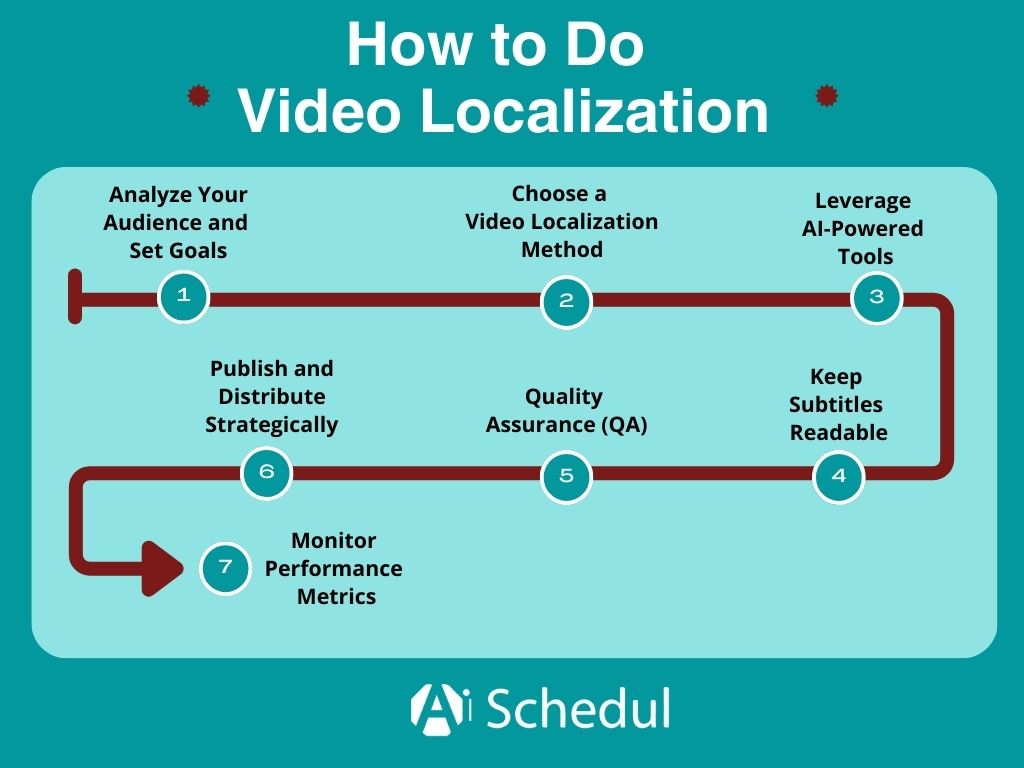
1. Analyze Your Audience and Set Goals
Start by determining which languages or regions you should localize for. Look at your website analytics, social media insights, customer data, etc., to identify where there is demand.
For example, you might find a lot of viewers from Spain and France – those languages would be prime targets.
Pro Tip: Always plan for localization early. If you know you’ll localize, you might also shoot scenes in a way that they don’t heavily feature text or specific cultural cues that are hard to change.
2. Choose a Localization Method
Decide if you’ll use subtitling, dubbing, voice-over, or re-creating parts of the video (based on your budget, timeline, and goals). This can help you decide on your next step.
3. Leverage AI-Powered Tools
Don’t forget to incorporate AI tools into your video localization strategy. It’s not time to redo every step of the video creation to turn it into another language.
Now, there are many AI video translation apps ready to help you localize your video, whether for adding subtitles or dubbing the main story with a new natural voice.
With the help of AI-powered tools, now you can focus on creating engaging social media video content instead of struggling with video translation.
If you wonder which AI translator tool to choose, here is the best option:
brandID: The Best AI-Powered Video Localization App
brandID.app is designed to let you translate your videos into over 200 languages with just a few clicks, producing results that maintain the original’s tone and style. It’s fast, user-friendly, and doesn’t require a subscription, making it accessible for marketing teams and creators alike.
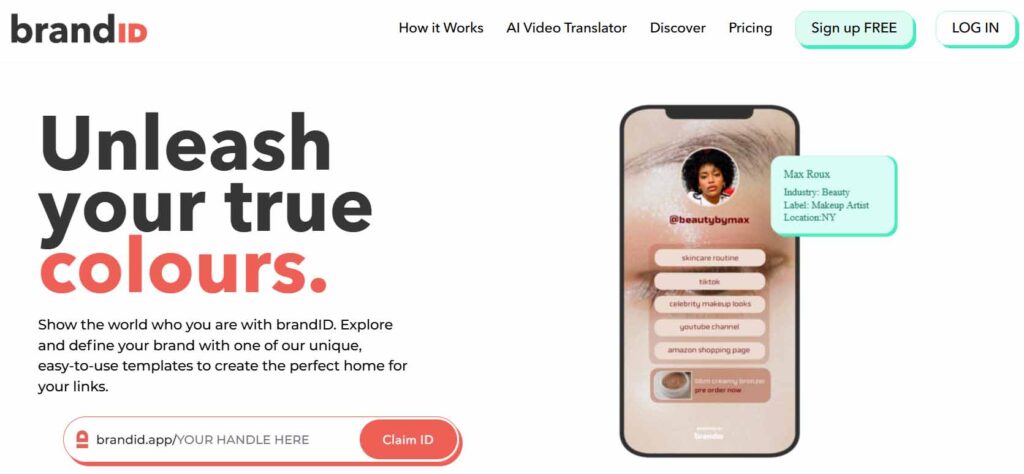
The tool doesn’t just do literal translation – it uses context to preserve the meaning and tone. The result is that your message stays impactful and authentic in each language.
Unlike most video translation tools on the market, brandID doesn’t require you to pay anything in advance as a monthly subscription fee or pricing plan; you can sign up for free, use its other features for free (which is a link-in-bio tool features), and only pay for each video you want to translate.
So, if you don’t frequently translate videos, you do not need to pay anything to the platform. Join for free and check it out yourself.
4. Keep Subtitles Readable
You can add subtitles and dub the video altogether. Meanwhile, it’s important to keep subtitles readable, especially for social media videos that people are watching on the small screen of their smartphones.
5. Quality Assurance (QA)
Before publishing the video, check the video with a native speaker to catch any errors, awkward phrasing, or cultural issues.
However, AI tools are wise enough and in most cases 99% correct. But it’s still worth reviewing it and making sure everything is properly synced with the visuals.
6. Publish and Distribute Strategically
Upload localized versions separately if needed (for example, a Spanish version, a French version) and optimize titles, descriptions, and captions for each target audience.
7. Monitor Performance Metrics
Don’t just throw the video on the internet, it’s essential to monitor its performance to see if it’s doing perfectly. This performance analytics can help you with your next video creation.
Case Studies and Video Localization Examples
Nothing can convince you about the effectiveness of social media video localization strategies than real stories. Check out the following case studies that show how you can benefit from localizing your video content creation.
Mr.Beast – YouTube’s Multilingual Phenomenon
One of the most cited success stories in video localization is YouTube superstar MrBeast. Originally creating videos in English, MrBeast saw an opportunity to reach non-English-speaking viewers by localizing his content.
He started by launching dedicated channels like “MrBeast en Español” and others, where his viral stunt and challenge videos were dubbed into languages like Spanish, Portuguese, etc. The result was explosive growth.
His Spanish channel was reportedly generating up to 100 million views per video in Spanish.
IKEA – Localized Home Inspiration Videos
Global furniture retailer IKEA is known for tailoring its marketing to local markets, and video is no exception.
IKEA runs separate YouTube channels for different countries, often producing videos in the local language featuring local lifestyles.
For instance, IKEA’s Turkey YouTube channel features collaborations with Turkish influencers and showcases homes with Turkish design sensibilities.
By localizing the content (both language and visual context), IKEA ensures that viewers in each region see content that feels made for them.
This strategy has paid off in engagement. Their localized videos often receive enthusiastic comments like “Thanks for doing this in [language], IKEA!” which shows the brand-building aspect.
Headspace – Meditation App Goes Spanish
Mental wellness app Headspace provides guided meditation videos. Recognizing the importance of language in something as personal as meditation, Headspace localized many of their videos into other languages.
They created, for example, Spanish voiceover versions of their guided meditation sessions. In one instance, a popular English meditation video was released as “Meditación Guiada” (guided meditation in Spanish)
This made their content accessible to millions of Spanish speakers who prefer or require their native language to fully relax and follow along.
The impact was significant: by offering their core content in Spanish, Headspace tapped into a huge new user base in Latin America and among Spanish speakers in the US.
Bottom Line
Video localization is not just a technical necessity but a strategic advantage for brands seeking to expand their global reach. As the digital landscape continues to evolve, investing in quality localization can differentiate a brand in a crowded marketplace, creating deeper connections and driving growth across international boundaries.
Use tools like brandID.app to localize your videos into other languages easily and cost-effectively.
FAQs
Q1: What is the Difference Between Video Translation and Video Localization?
Although Video translation is a component of video localization, they are not the same. Generally, video translation refers to converting the spoken or written words in a video from one language to another (e.g., translating from English into French video or text).
On the other hand, localization is a broader term that includes translation but also encompasses adapting cultural references, visuals, units of measure, formatting, and anything else necessary to make the video suitable for a specific locale.
Q2: Should I Use Subtitles or Dubbing for My Videos – Which Is Better?
You can use both. There is no rule to use only one of them. Subtitles can help you get your message to viewers who are mostly into reading or would mute videos when they are at work or in public. It’s a quick and cheap type of localization.
Dubbing (voiceover) is often preferred for content where emotional impact or ease of viewing is important. If budget allows, dubbing usually results in higher average watch times and viewer satisfaction because people can listen in their own language.
Q3: Is Video Localization Very Expensive?
Not necessarily if you use the right tool. Traditionally, localizing a video (especially dubbing) involved hiring translators, voice actors, studios, and editors – costs could add up quickly, making it pricey to do multiple languages.
However, with new technologies like AI-powered video translation tools (e.g., brandID.app), the cost has dropped dramatically.
Q4: How Long Does It Take to Localize a Video?
With AI tools for video content creation, now localizing can be done with only a few clicks. It won’t take all day or a week to change the language of a video. Just upload it to apps or online translators like brandID and translate it with only a few clicks.
Q5: Do I Need Separate Social Media Accounts for Each Language?
It mostly depends on your target audience, brand strategy, and resources. For example, if you have a significant audience that speaks different languages, creating separate accounts can be more helpful than the times you don’t have much audience.
On the other hand, managing multiple accounts requires additional time and effort to maintain consistency, engage with users, and produce quality content in each language. If resources are limited, you might opt for a single account and use multilingual posts.


